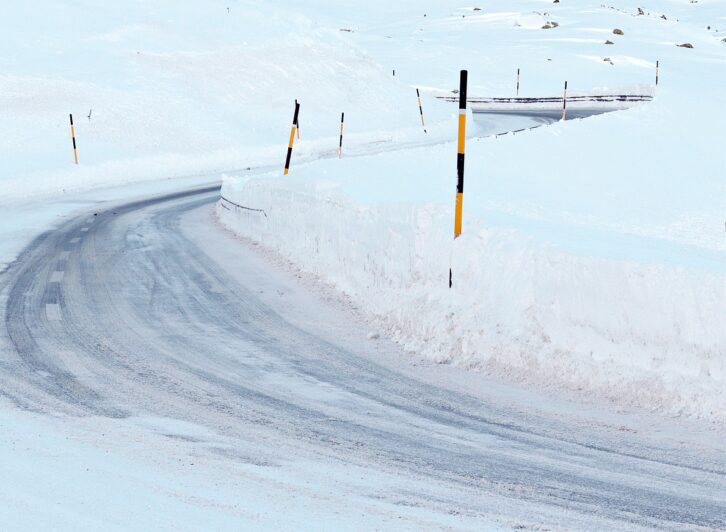It goes without saying that adverse weather conditions can affect the flow of goods, both nationally and internationally. But it can be easy to underestimate exactly what scale this impact can have. In the UK, a government report from the House of Commons Transport Committee on severe weather in the winter of 2010 – which closed Heathrow Airport entirely for a three-day period and significantly affected road and rail transport – reduced the UK’s GDP by a total of 0.5%, and cost the national economy around GB£280 million per day. In this blog, we’ll look in a little more detail at how adverse weather can affect road haulage, air freight and ocean freight.
Road haulage
Extreme weather – and in particular heavy snowfall and icy conditions – can cause serious disruption to road traffic. According to the Freight Trade Association, jack-knifing lorries are one of the primary causes of motorway or interstate highway closures nationwide.
In the most recent adverse weather spell in Britain, the UK Met Office deployed its multi-tier weather alert status indicators, issuing either a yellow, amber or red alert depending on both the likelihood and potential impact of severe weather conditions, covering rain, snow, high winds, fog and ice.
Advice for road haulage drivers in the event of extreme weather warnings highlight the relative severity of the different levels of alert. In amber alerts, drivers are advised to be mindful of the weather and its possible impact, and to ensure goods vehicles are prepared for those effects. This can vary depending on the exact type of adverse weather but can include, for example, ensuring that tyres are in good condition with a sufficient tread depth in wintry conditions, and that tyre pressure is regularly checked and maintained. It’s also recommended that lorries are equipped with a lightweight shovel and tow rope and, where possible, a bag of road salt or grit to assist with traction.
In red alert conditions – meaning extreme weather, widespread damage and possible risk to life – HGV drivers are advised to leave the road network, find a safe place to park and only resume travel when the alert has been downgraded to amber.
Air freight
While coverage of flight disruption at airports due to adverse weather tends to concentrate on cancelled commercial flights and stranded passengers, the importance of airports as hubs for international air freight can’t be overstated. The winter storm that lashed the UK in early 2018 demonstrated just how disruptive severe weather can be.
When looking at both the extreme weather around that time, cancelled flights ran into the hundreds, delaying deliveries and leading to widespread disruption to global supply chains. While airports closer to the Earth’s poles were better prepared to face wintry weather, those accustomed to warmer weather suffered from a lack of both the experience and the equipment to deal with unprecedented heavy snowfall – which reached up to 18 inches in some areas in the UK, severely disrupting air freight.
Where extreme weather does come into play, delays can sometimes be unavoidable as we take steps to look after the wellbeing of our vehicles, our people, and our clients’ goods. However, at HGL we pride ourselves in having robust contingency plans in place to deal with adverse weather conditions, and wherever possible we work with our world-class global partners to help minimise the impact of adverse weather on our valued clients.
Ocean freight
Ocean shipping can be particularly prone to disruption by adverse and extreme weather conditions, not least because shipping lanes can be dependent upon factors such as channel depths and the extent of sea ice. Extreme flooding, for example, can close shipping channels, while silt and debris build-ups from flood runoff can make some channels shallower and less accessible. In extreme wintry weather, snow and ice accumulation on freight vessels’ decks and rigging can also be problematic, while wave swells in stormy conditions can, and do, cause ocean freight vessels to lose loads.
It’s not just ocean freight ships and shipping lanes that can be affected by adverse weather – ports can also be vulnerable to the impacts of extreme weather conditions, with potentially considerable knock-on effects to supply chains, and ultimately the broader economy. One example is the United States’ Gulf Coast region, which the Environmental Protection Agency has identified as being particularly vulnerable to the effects of coastal storms. The Gulf Coast contains seven of the United States’ ten largest ports, with 56% of all oil imported to the US arriving via these ports. Should severe storms cause closures or significant delays in and around those ports, it’s easy to see how substantial the impact could be economically.
Where extreme weather does come into play, delays can sometimes be unavoidable as we take steps to look after the wellbeing of our vehicles, our people, and our clients’ goods. However, at HGL we pride ourselves in having robust contingency plans in place to deal with adverse weather conditions, and wherever possible we work with our world-class global partners to help minimise the impact of adverse weather on our valued clients.
